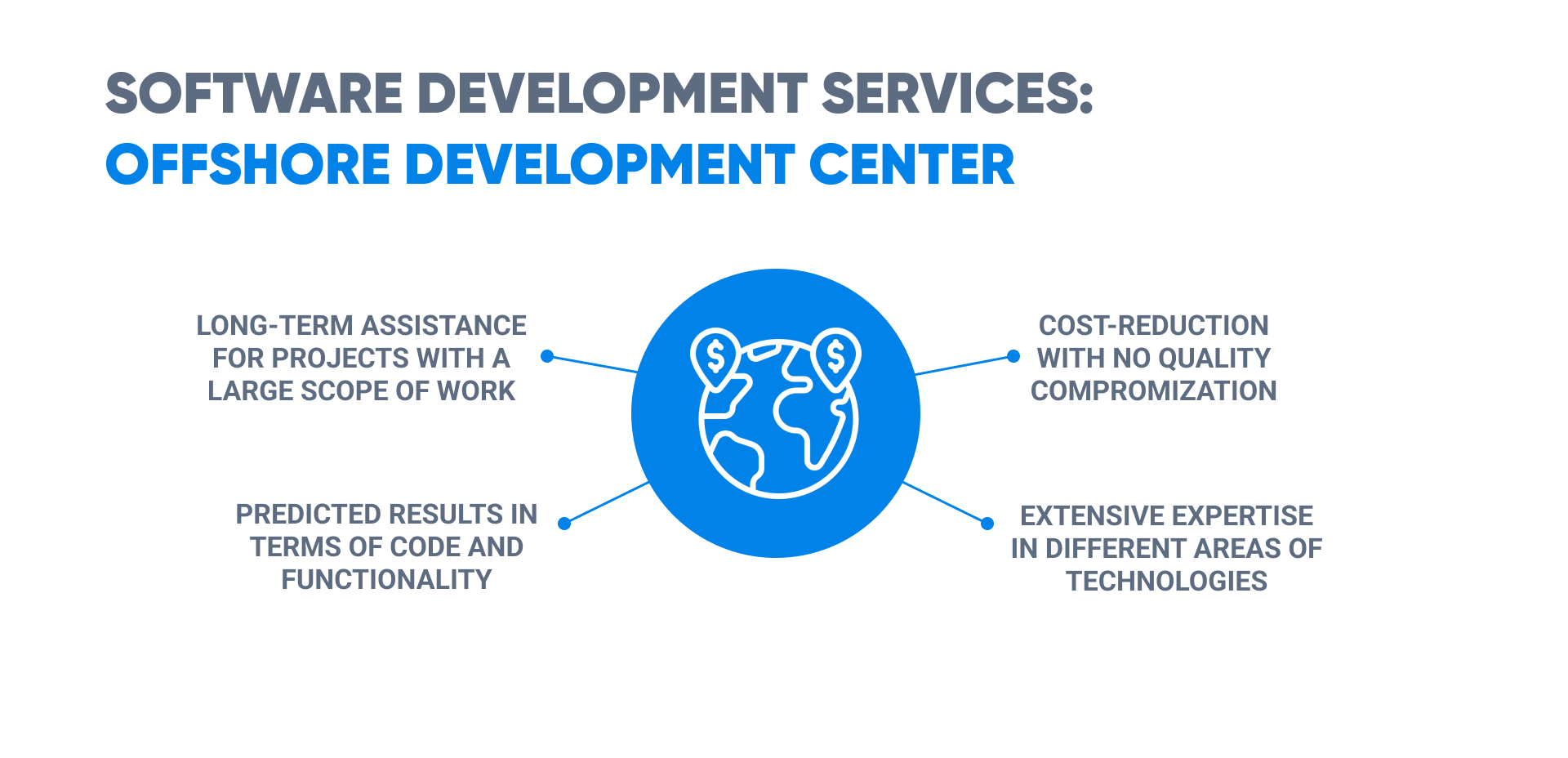
They say that if you doubt something, you should go back to the beginning. There is both a kernel of truth and contradiction as we often notice the mistakes we made only when there is no way back. When it comes to the development of a new software product, one can avoid mistakes only by picking the right software development model at the jumping-off point: while defining the outstaffing model and starting work with the dedicated team.
Only the strategy that dances around their context and capabilities can increase the productivity of the team, reduce the number of defects in the final code, and simplify the further support and scaling of the product.
Yes, analyzing your current needs and the level of digital readiness is the hardest thing in the process but we are here to help. Having an active role in implementation of different software development models (engagement models in software) for our customers, we accumulated a great deal of first-hand experience. In this article, we want to share it with you to get your project a flying start. For your convenience, we broke down each model by:
- types
- business models
- service models
Software development models: industry overview
A software project development plan is a set of processes and methodologies applied to project development. In the process, you may notice various types of software development life cycles as well as business and service patterns of different complexity levels. Each has its focus and pre-programmed results that should be achieved. Opting for a particular development plan you should take into consideration the following points:
- time frame indicates when the customer should receive the first intermediate results, and whether this time can be extended
- terms include project specifics like project constraints, compensation, and budget, as well as clauses regarding time frames and required progress indicators
- project size i.e. how big the project is and how many people are involved
- scope of the project shows how the project can affect the company’s work processes in a long run and helps to predict their scaling
- engineer skill level indicated the level of seniority of people involved
- goal indicates the further potential use of an application and the specific areas it might be used
- a programming language that is used for the project and sectors it will be used
In essence, the choice of any software model is always based on specific business needs and project goals. This choice is also crucial because starting with one pattern, it cannot be changed to another later. That’s the reason why companies often choose different software development models for different projects.
Nurturing a project in the cozy in-house atmosphere of your company is simply a challenge, while the need to globalize and scale is indeed a catch for many. That’s why recently software development trends lean towards offshore development.

Outsource Software Development: why does everyone choose one
The priority of any business today is savings and increased capabilities as everyone is interested in conquering new markets fast. In this regard, outsourcing of software development services is an effective solution that according to estimations may provide up to 58% savings.
Many companies are turning offshore to hire resources at lower rates in countries with cheaper labor instead of adding local specialists with a higher rate to their teams. In addition, the internal hiring of employees requires high costs, which cover health insurance, vacations, and regular review of salaries. The logical question is, why not engage specialists from your country? Well, this option has its limitations.
“Today, companies realize that the main element they lack today for digital transactions is talent.”
Due to high prices, specialists from many countries in Europe and North America have some of the highest wages among developers. Speaking of the developer services in these countries, it may cost about $100-200 per hour. In Asia, for example, it ranges from $25 to $45 per hour, depending on the level of his expertise.
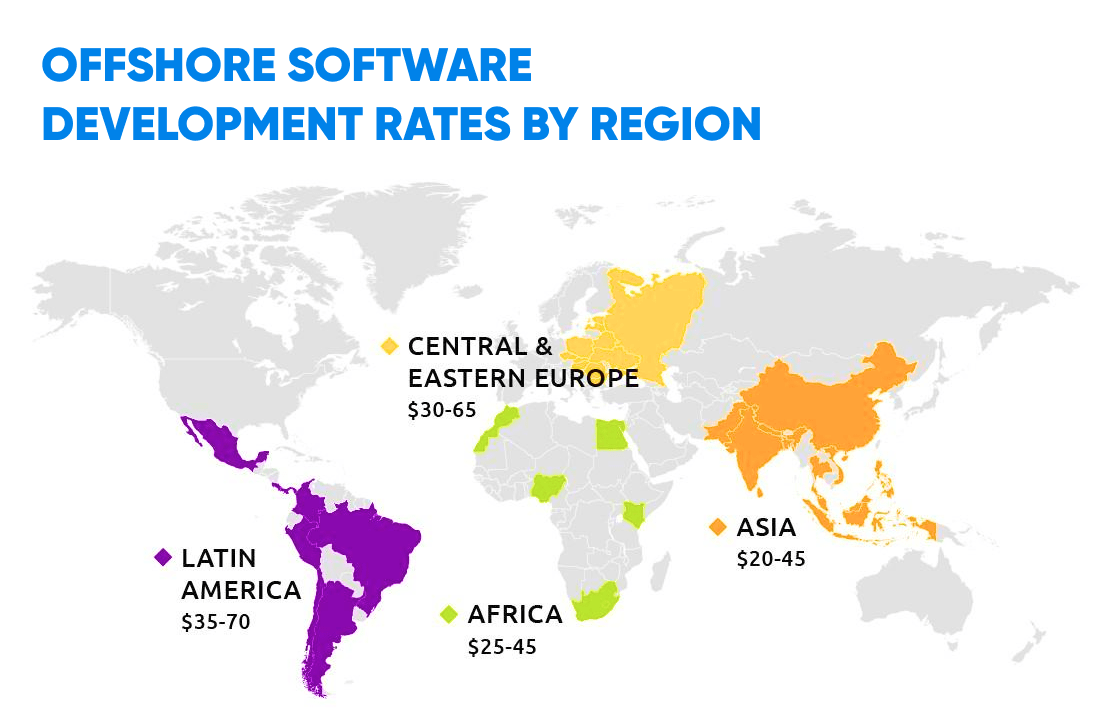
Ukrainian specialists, for example, have a high level of seniority and offer a high level of services and English language proficiency that, in the end, greatly simplifies the process of work. The majority of Ukrainian developers are middle — 36%, for example, and indicate the interest in technology as the main reason for choosing their job.
That’s why, among different software development industry trends, outsourcing has become a natural step for many businesses, which allows them to reduce costs and conquer the international market faster.
Want to see an example? MWDN has a great number of projects in outsource software development that have resulted in success stories for our customers.
Types of offshore development model
If you decide to step on the offshoring path, first, you must decide whether to employ nearshore, offshore or onshore, as well as the impact of this decision. Each of these paths has its specifics.
Offshoring
Offshore is a model when a client chooses a software development company in a distant country. For example, a US or Canadian company hires developers from Ukraine or Poland. Both businesses with a limited budget and big companies that want to globalize fast opt for this model. Different economic conditions in different countries create a situation that allows them to hire great software engineers at a lower cost. That is why leaders of many industries like Google, Apple, and Amazon have found a day in offshoring.
However, you are very wrong to think that one chooses offshoring primarily as an option to save money. Amid the high competition for talents, these companies also get access:
- a seemingly inexhaustible supply of talent in different countries
- great speed on the market
- significant reduction of operational costs and tax expenses
The downside of this model can only be that the customers are unlikely to ever meet their team in-person. In addition, they may have some problems with the understanding of the language and cultural differences.
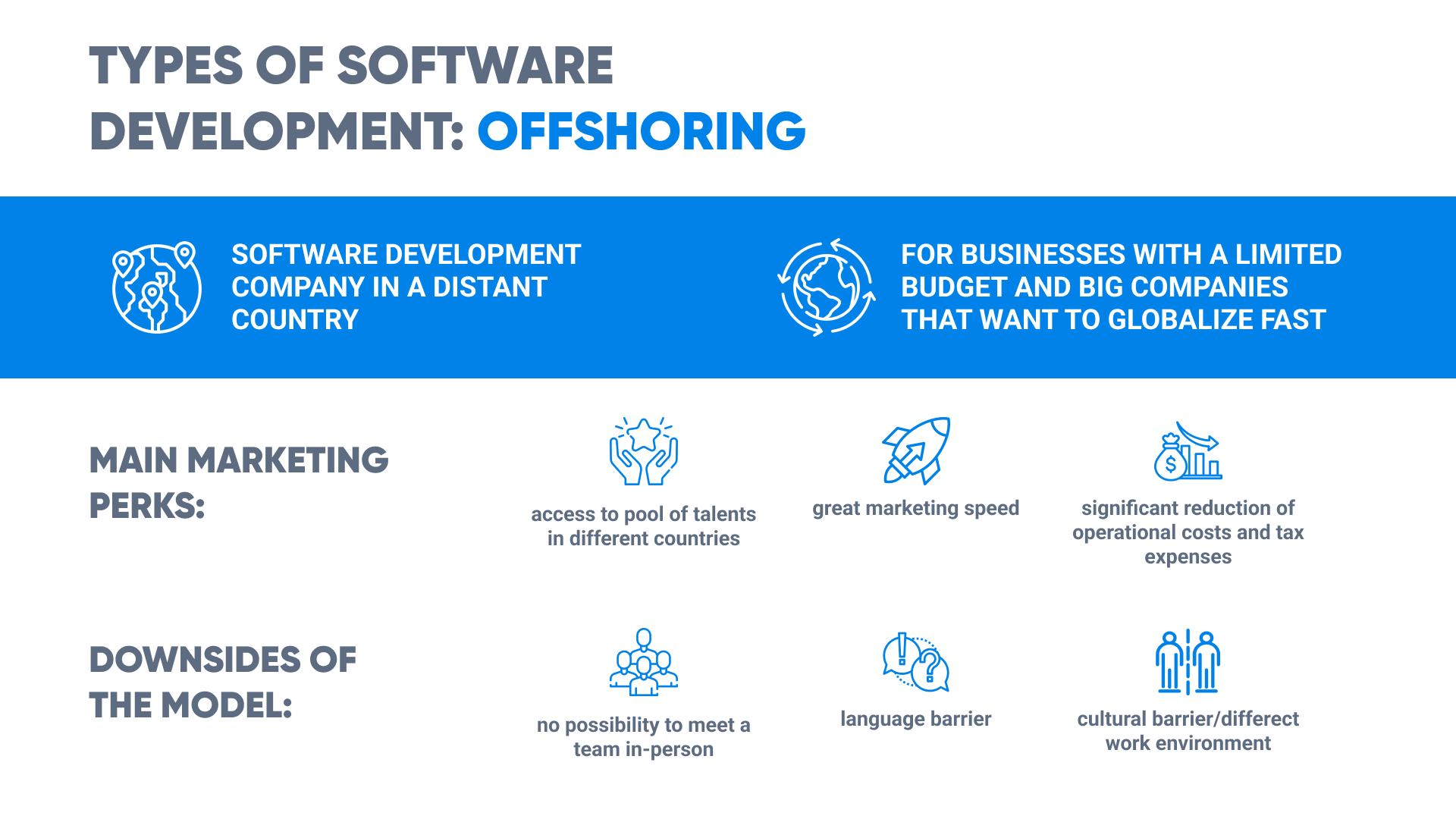
Nearshoring
Nearshoring is outsourcing to a neighboring or nearby country. Unlike offshoring, this model allows companies to visit their outsourcing partner and have face-to-face meetings regularly (once a week/month, etc.)
It means that nearshore software development companies are more immersed in customers’ business context and have a more profound understanding of their values. Nearshoring allows one to enjoy a similar cultural and work environment with the partner, which helps to establish more personal relationships and gain more control over the core activities. Customers can even invite the chosen nearshoring team to their office on a regular basis.
However, the higher price and the ability to choose specialists from a limited number of countries impose some limitations on this model. In addition, the customer should also largely control the work of the developers, being involved in the process to the same extent as the team.
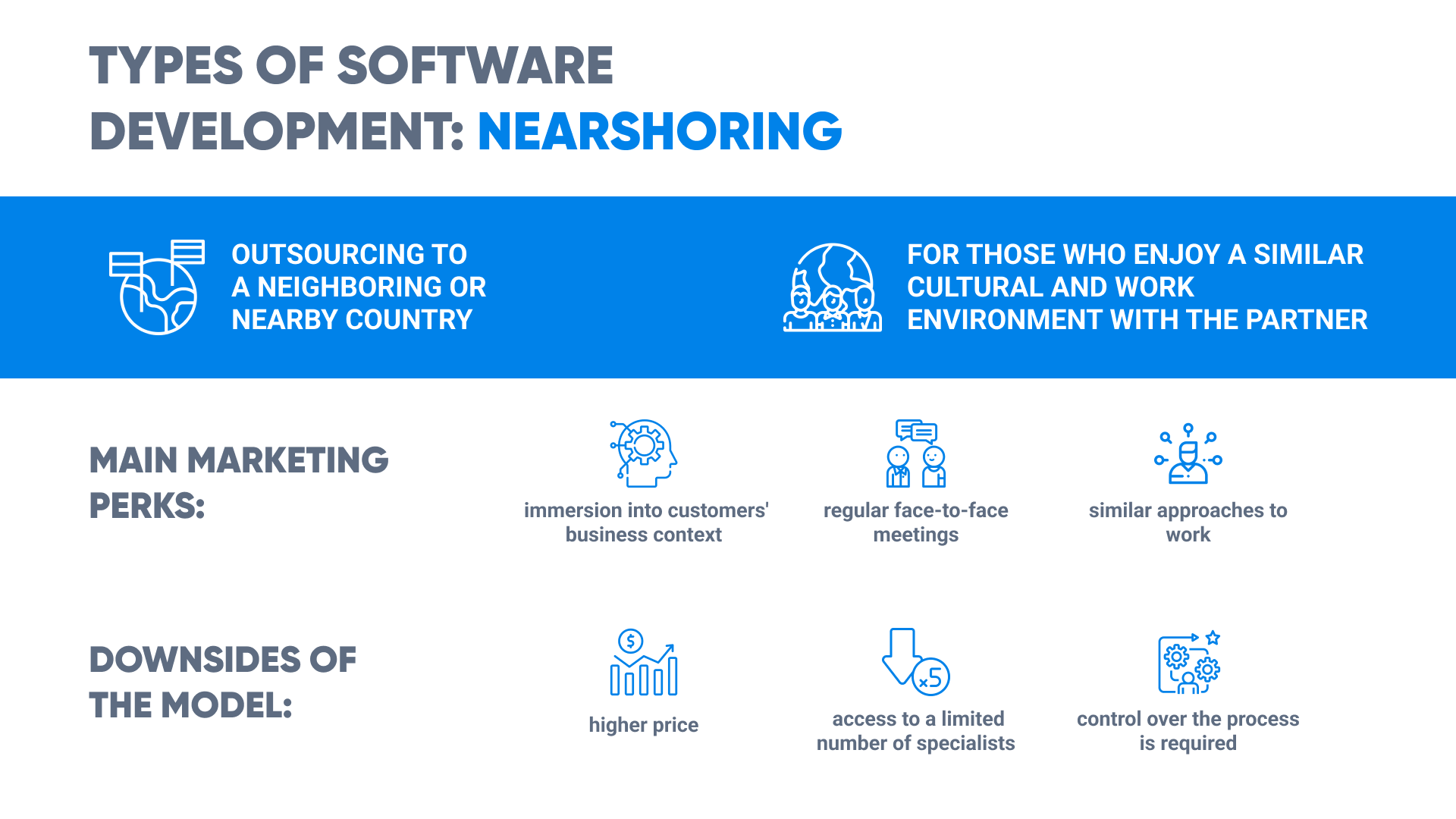
Onshoring
Onshoring means the outsourcing of services within one country. Practically every country has cities that are considered the centers of software development (Silicon Wadi in Israel, Kyiv, Kharkiv, and Dnipro in Ukraine.) Saving time on searching for a partner and choosing among local service providers does not seem like such a bad option. Indeed, onshoring comes in handy for everyone who supports this logic and doesn’t need to globalize fast. The businesses that develop software onshore have a greater choice of partners and enjoy a better price policy and more favorable terms of cooperation.
However, this option is not always available due to the high price and the high chances of getting lost among competitors who use the same insights and analytics to build the products for this market. After all, this approach is not an option for businesses whose goal is conquering the global market as it makes them stay in their comfort zone and use only the advantages of the local market.
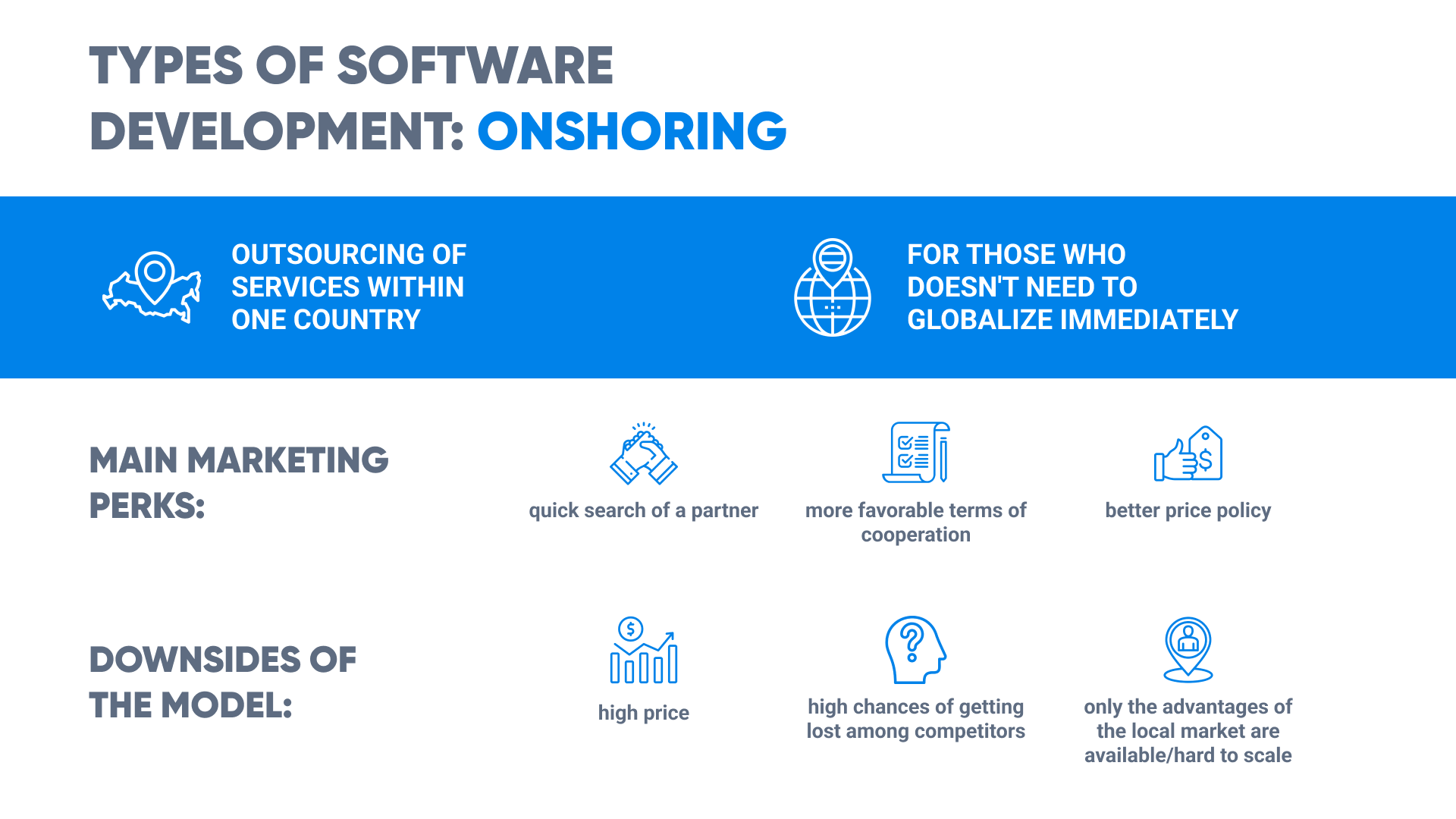
Software development by business models
Choosing the right business model of interaction with the service provider allows customers to have a clear picture of their project investment.
Fixed cost model
One of the most popular software outsourcing models is called “fixed cost”. It implies that the budget is pre-fixed at the beginning of the project and cannot further be changed. This way, the possibility of hidden or unexpected costs is eliminated. Due to fixed pricing, this model is a win-win situation for small and medium-sized enterprises as it helps them feel much more secure regarding their expenses and have a clear idea of project costs.
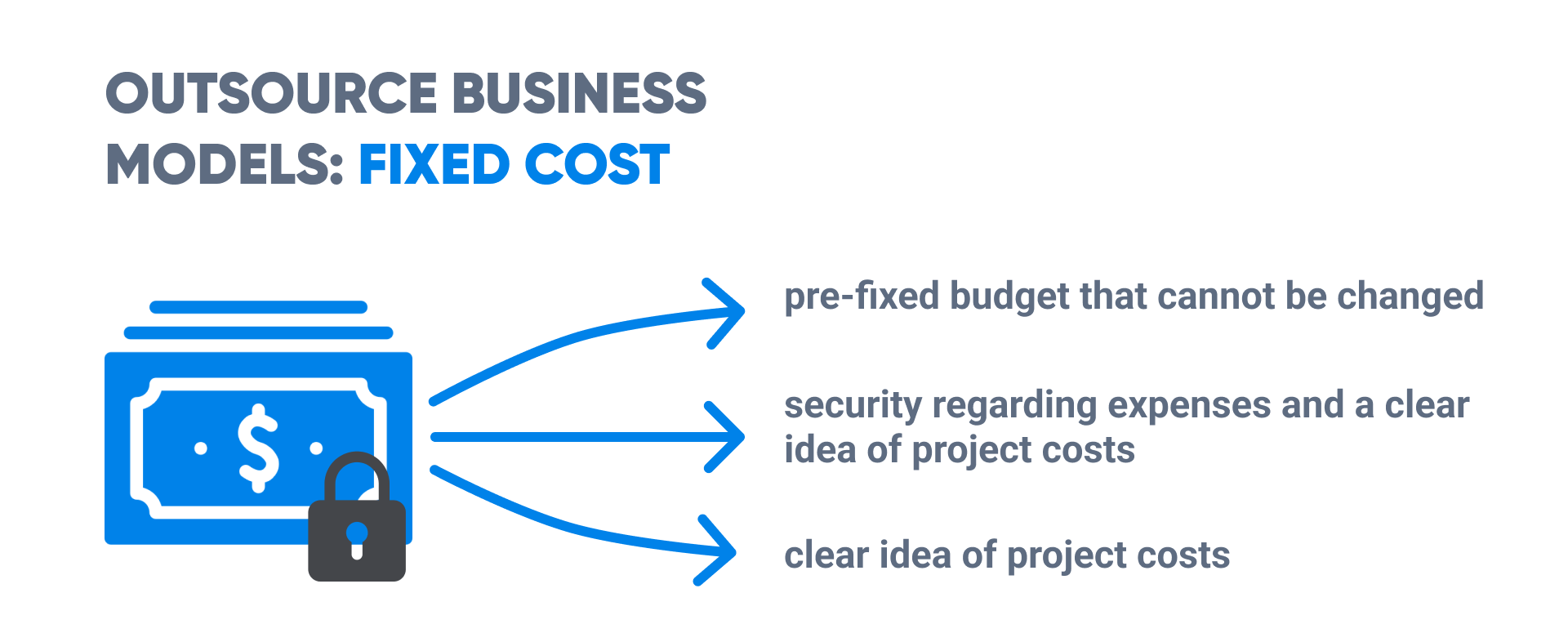
Hourly / time and material software development
Hourly or “time and materials contract software development” is a narrow offshore software development model applied when it is hard to estimate the total scope of work at the beginning. This option is more flexible for businesses as only the time frame is set in advance while the amount of work can be changed in the process. This way, the customer pays only for the actual amount of time and effort spent on the implementation of the project.
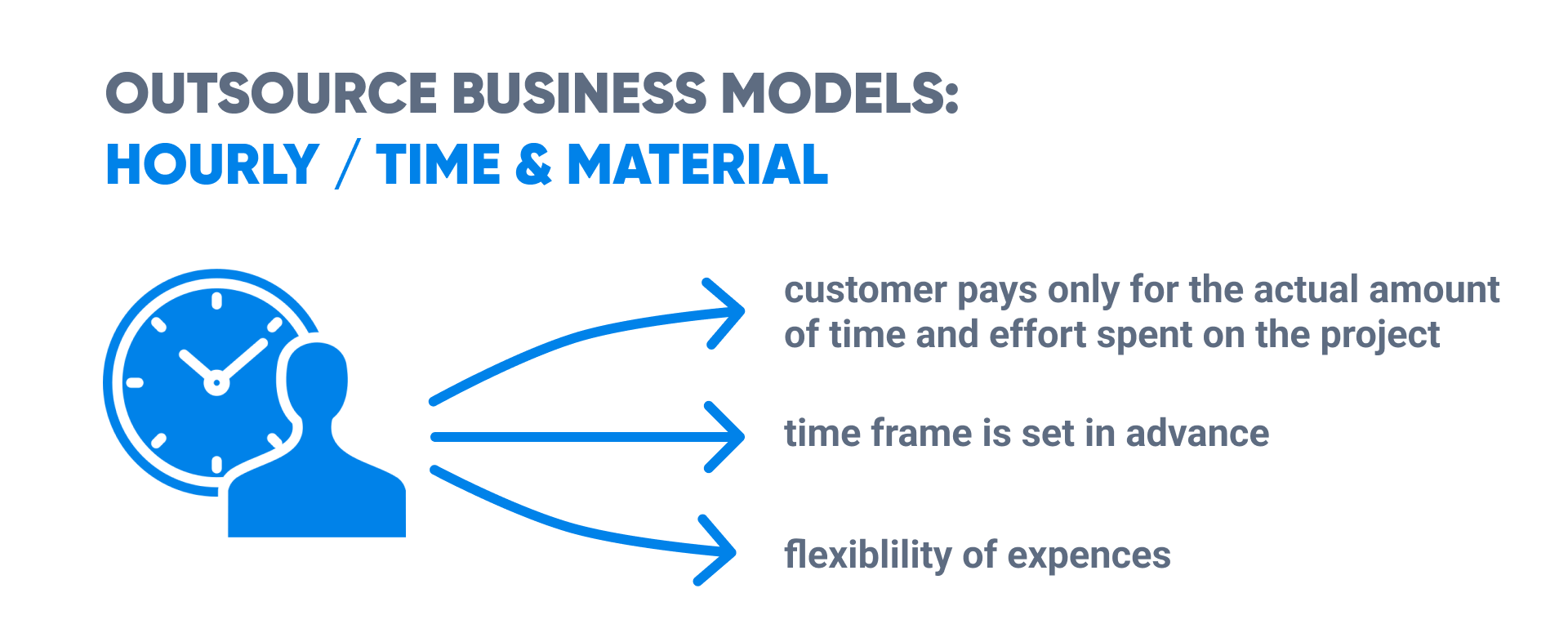
Dedicated development team or dedicated resources model
Often the success behind a project is a dedicated team of offshore developers. The development of a big project is a time-consuming process that requires a lot of assistance. Sometimes, the participation of a dedicated team to maintain its work is required.
A dedicated team, consisting of specialized divisions, is engaged in one project at a time and has complete responsibility for technology, architecture, and generated code. Once the active development phase ends, most developers can be moved on to another project, except for a few specialists who continue to control the code and improve it further.
Want to hire a dedicated team in Ukraine? Learn how much it cost here.
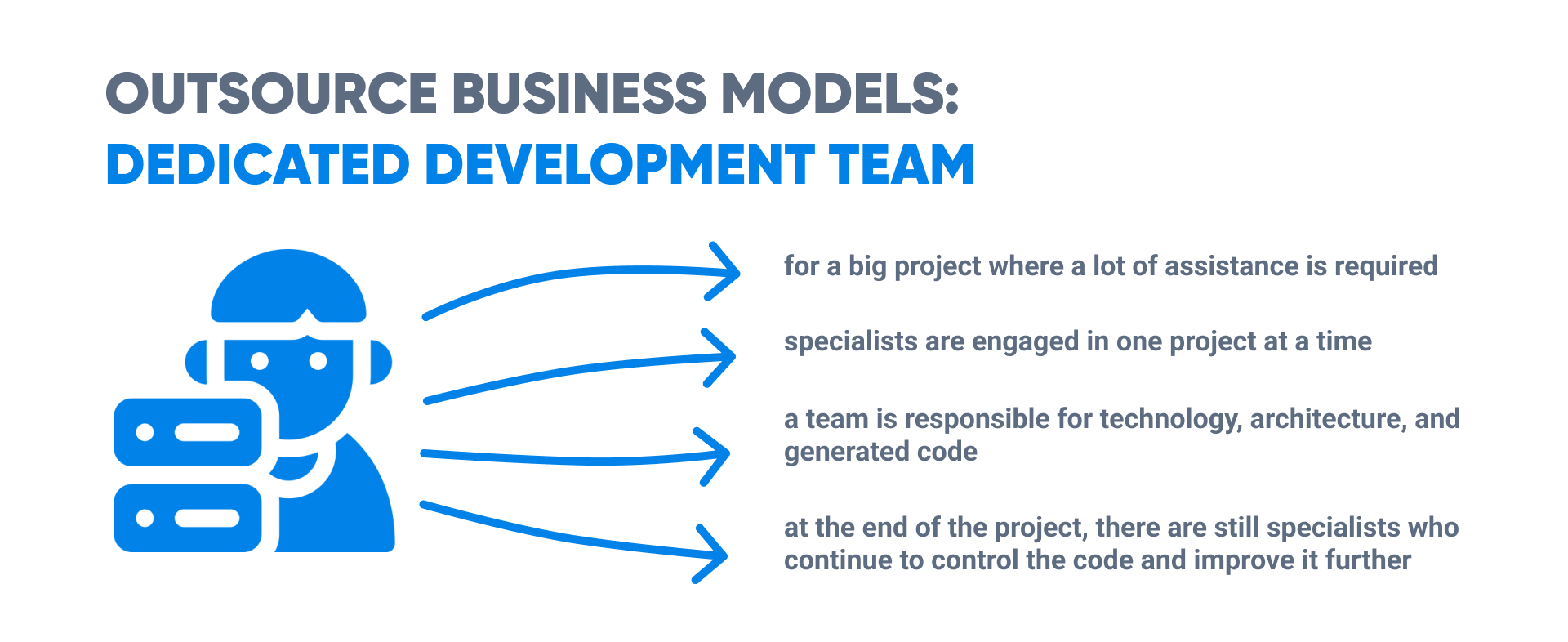
Software development model by services
Staff Augmentation
This simple but effective software development model means the reinforcement of the company’s internal staff with offshore developers who become a full-fledged part of the team. The main advantage of what is also referred to as outstaffing is the ability to attract the right developers only when the customer really needs their assistance, and to avoid spending an extra budget.
Although in this case, the customer has to directly manage an extended staff, it helps to add to their in-house team with just the right expertise. In addition, working on the customer’s premises, these specialists are deeply immersed in the business context of the customer. With a special recruitment program, a customer also can control the recruitment process, choosing only the best specialists in the industry.
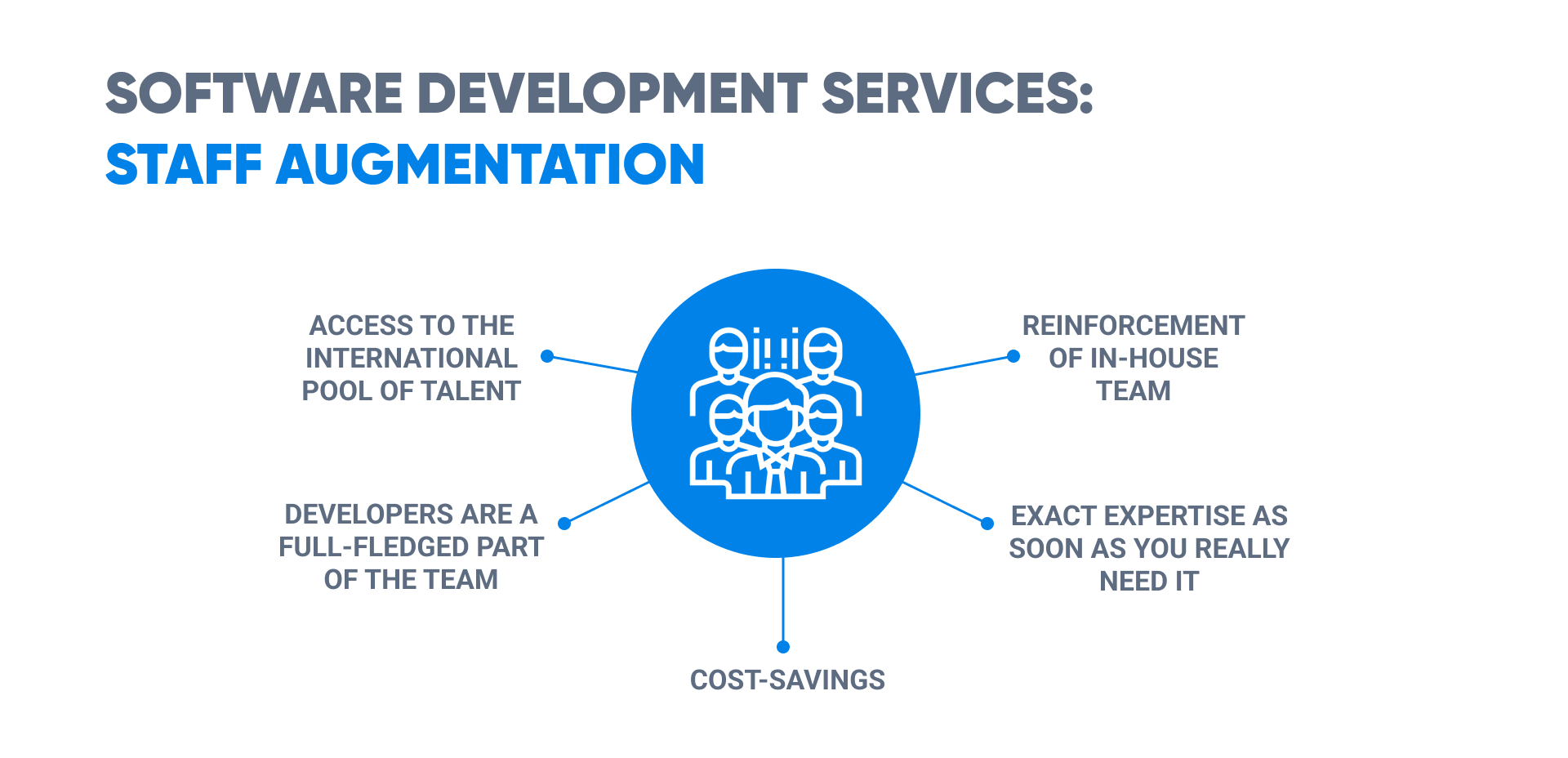
Looking for a trusted software development partner? In Israel and around the world, MWDN finds perfect candidates in the shortest terms possible.
Offshore Development Center
The availability of the offshore development center is the best choice for long-term projects with a large scope of work. It becomes a good fit for companies that are well aware of all the complexities and pitfalls of developing their projects and are ready to invest in a long-term team that provides exact results in terms of code and functionality. This is widely used by companies that need to reduce costs without compromising quality and reducing available development resources.
It works as follows: the customer selects and reserves a team of dedicated offshore developers that has extensive expertise in particular technologies, architecture, experience, and knowledge that are required for a certain project. The involved developers work on only one project at a time and are completely client-driven. This structure allows the customer to be sure that the team will meet the requirements of the project and will be able to perform the necessary functions on time.
Project-based
When you realize that your development needs may change during a project, or if you operate in a rapidly changing market, you should skip the project-based software development and rather prefer a dedicated development team. After all, the project-based software development model is used only for projects with clearly defined requirements that, most likely, will not change during the development process. The project-based software development model also benefits the customer in terms of reduced costs and shorter time to market. How? The team in this case already knows the technologies used in the project combined with relevant experience in certain business verticals.
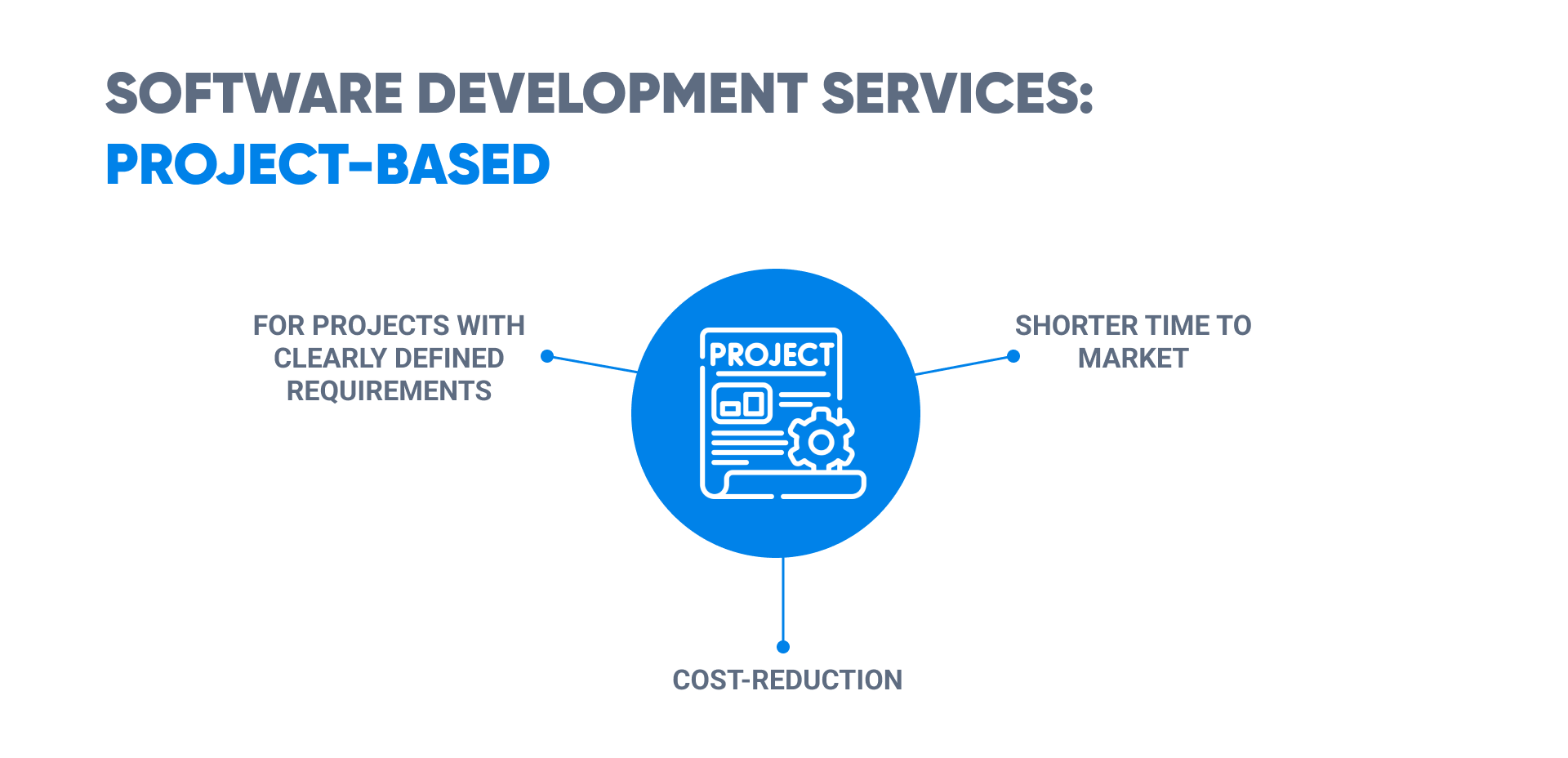
Summary
When there is a variety of software development models, it is always difficult to choose one. The key is that every search should begin with a thorough examination of your goals, objectives, and readiness to invest. Only this way, you may have a clear vision of the outcomes and an understanding of where exactly the project will pay off.
We don’t forget that it is equally problematic to find the one among different software development cycles. Luckily, very soon, we will provide you with some fresh market insights on this topic – in our social feed.
Once you have any questions or are having trouble finding the best strategy for your product among different models of software development – the assistance is just a few clicks away.

